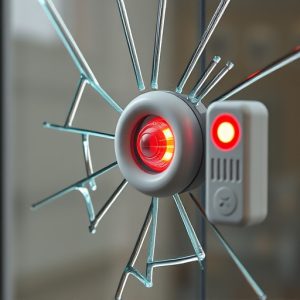Securing Your Home: The Comprehensive Guide to Glass Break Alarm Sensors
Glass break alarm sensors are essential components of modern home security systems, designed to dete…….
Glass break alarm sensors are essential components of modern home security systems, designed to detect and respond to the acoustic signature of breaking glass. These sensors utilize advanced algorithms and microphones to accurately identify the sound of glass being broken, minimizing false alarms and ensuring that only authentic breach attempts trigger an alarm. They come in various types, including acoustic, magnetostrictive, linear acoustic, and infrared sensors, each suited to different environments and scenarios. Proper placement and calibration are crucial for optimal performance; sensors should be installed on or near windows and doors, especially those more susceptible to break-ins, and adjusted for sensitivity according to the manufacturer's guidelines and environmental factors. Regular maintenance, including visual inspections, cleaning, testing, and updating software, is necessary to maintain their effectiveness in protecting against unauthorized entry and ensuring that they provide a reliable layer of security for residential or commercial properties.
Glass break alarm sensors represent a critical component in modern home security systems, offering a swift response to unauthorized window or door breaches. This article delves into the inner workings of these devices, their integration into broader home security strategies, and a comparison of various types available. Additionally, readers will glean valuable insights on optimal installation and configuration to enhance system performance, as well as maintenance practices to maintain sensor reliability and effectiveness. A comprehensive guide for safeguarding your home with the most advanced glass break alarm sensors, this piece is an indispensable resource for securing your living space.
Understanding the Mechanisms Behind Glass Break Alarm Sensors
Glass break alarm sensors are a critical component in home security systems, designed to detect the sound of breaking glass and alert homeowners or security monitoring services immediately. These sensors operate on the principle of audio frequency detection, specifically tuned to recognize the unique acoustic signature of glass breaking. Upon activation, which can be triggered by the distinct frequency patterns associated with breaking glass, the system emits a high-pitched chime or activates an alarm to deter intruders and signal the occurrence of a potential breach.
The mechanism behind these sensors involves microphones positioned strategically within the vicinity of windows or doors. These microphones are sensitive to sound waves within a specific frequency range that corresponds to the sound of glass fracturing. Advanced models incorporate algorithms that distinguish between the sound of breaking glass and other noises, thus minimizing false alarms due to loud events like construction work or thunderstorms. This technology ensures that only genuine threats activate the alarm, providing an additional layer of security for homes and businesses alike.
The Role of Glass Break Alarm Sensors in Home Security Systems
Glass break alarm sensors play a pivotal role in the multifaceted realm of home security systems, offering an additional layer of defense against potential intruders. These sophisticated devices are designed to detect the unique sound frequencies that accompany the breaking of glass, distinguishing them from other common household noises. Upon sensing an event that matches these frequencies, the sensor triggers an immediate alarm, alerting inhabitants and authorities alike to a potential breach. This swift response not only deters criminals but also provides valuable time for occupants to respond and for security personnel to assess the situation. The integration of glass break sensors within a home security system enhances its effectiveness, creating a comprehensive protection network that is both responsive and proactive in safeguarding one’s property and peace of mind.
The functionality of glass break alarm sensors is underpinned by advanced technology that utilizes microphones to monitor acoustic patterns. These sensors are tuned to recognize the specific sound profile of glass fracturing, filtering out other non-threatening sounds. Their high sensitivity and low false alarm rate contribute to their reliability as a security feature. Moreover, they are often pet-friendly, differentiating between the shattering of glass and harmless activities involving pets, ensuring that homeowners do not experience nuisance alarms. The strategic placement of these sensors within a residence can cover various points of entry, creating a comprehensive acoustic barrier that complements the physical barriers provided by window and door alarms. This integrated approach to security ensures that any attempted glass break-in is swiftly detected and addressed, making glass break alarm sensors an indispensable component of modern home security systems.
Comparing Different Types of Glass Break Alarm Sensors on the Market
When securing residential or commercial properties, selecting the right glass break alarm sensor is paramount for effective protection. On the market, there are various types of glass break alarm sensors, each with its own set of features and capabilities tailored to different environments and needs. Acoustic sensors, for instance, detect the sound frequencies that shattering glass emits. They are highly sensitive and can differentiate between potential threats and harmless noises like breaking plates or construction sounds. Magnetostrictive sensors, on the other hand, rely on a transducer that converts electrical signals into mechanical vibrations; these vibrations travel through the glass and are detected when an impact occurs, signaling a potential breach.
Another type is the linear acoustic sensor, which monitors for the specific sound patterns associated with glass breakage. It’s designed to ignore ambient noise, reducing false alarms. Infrared sensors, meanwhile, work by detecting the infrared light that is emitted when glass is broken. They are particularly useful in areas with high acoustic noise levels or where visibility is restricted. Each sensor type has its advantages and limitations; the choice between them depends on factors such as the size of the area to be protected, the environmental conditions, and the specific security needs of the premises. Users must consider the compatibility of the glass break alarm sensor with their existing security system and the sophistication of detection technology required for optimal protection. It’s crucial to evaluate these aspects to ensure that the chosen sensor provides robust deterrence against unauthorized entry.
Installation and Configuration Tips for Optimizing Your Glass Break Alarm System
When installing a glass break alarm sensor, strategic placement is paramount to ensure optimal detection and security. Begin by examining the areas most susceptible to attempted break-ins or where glass panels are likely to be targeted. These sensors should be positioned on or near windows and doors, particularly those that are more exposed or less visible from the street. During installation, adhere closely to the manufacturer’s guidelines; these often include specific orientations and distances from potential points of entry. Additionally, avoid placing the sensors on frames with double glazing or tinted glass, as this can interfere with their functionality.
Upon installation, configuration is the next critical step. Calibrate the sensor to differentiate between normal sounds like wind or temperature changes and the distinct sound of breaking glass. This calibration process typically involves adjusting sensitivity levels through the system’s interface. It’s advisable to start with a lower sensitivity setting and gradually increase it until the sensor reliably detects glass breakage without producing false alarms. Regular testing and fine-tuning may be necessary, especially if environmental factors change or renovations are made to your property. Remember to keep software and firmware up to date to benefit from any improvements in detection algorithms that the manufacturer may release.
Best Practices for Maintaining and Testing Your Glass Break Alarm Sensor to Ensure Reliability and Effectiveness
To ensure that your glass break alarm sensor remains a reliable deterrent against intrusion, regular maintenance and testing are imperative. Begin by inspecting the sensor for any signs of physical damage or debris accumulation, as these can impede its functionality. Dust the sensor carefully with a soft, dry cloth to maintain its sensitivity. The optimal positioning of your glass break alarm sensor is crucial; it should be installed where it has an unobstructed view of potential points of entry. Regularly check that the sensor’s field of vision is clear and that no furniture or fixtures cast shadows over it, as this can cause false alarms or prevent the detection of a break-in attempt.
Testing your glass break alarm sensor should be a routine part of your security system maintenance schedule. Perform a test activation to confirm its responsiveness. This can be done by simulating the sound of breaking glass within the range specified by the manufacturer, ensuring that the sensor’s alarm is triggered as designed. Additionally, verify that the sensor communicates effectively with your central alarm system, triggering both local and remote alerts as necessary. Keep a log of all tests and maintenance checks to monitor the performance of your sensor over time. By adhering to these best practices, you can maintain and test your glass break alarm sensor, thereby ensuring its reliability and effectiveness in safeguarding your property against potential security breaches.


